Two Kinds of Reunification: Hoi An to Khe Sanh
- Aaron Schorr
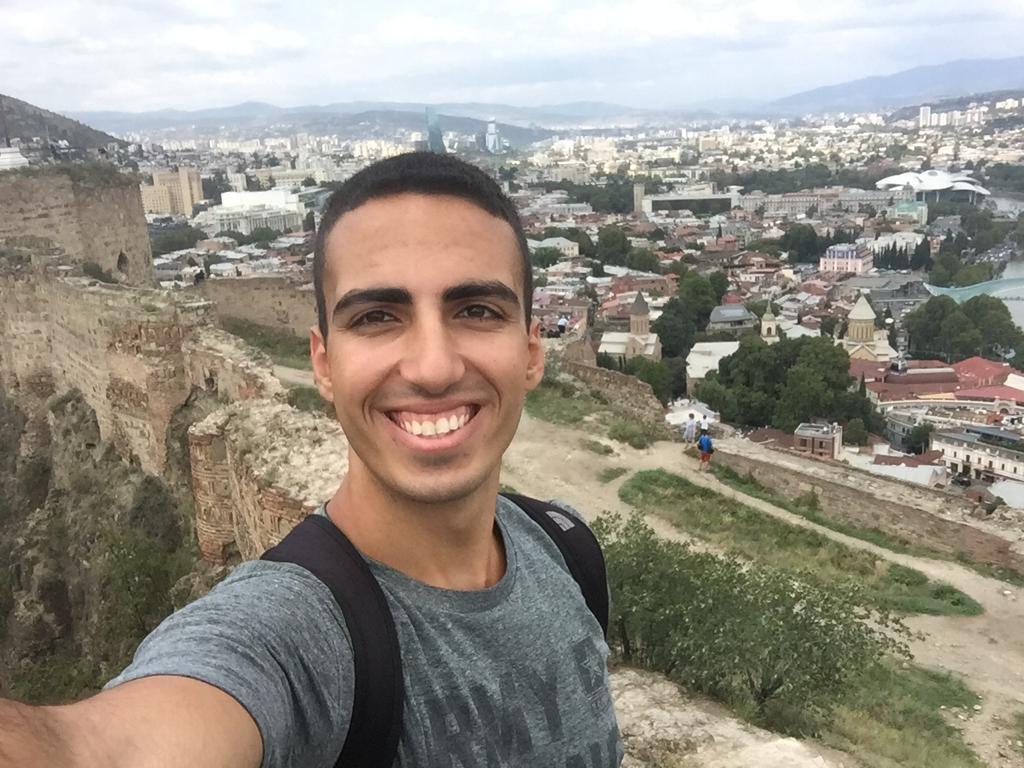
- Feb 5, 2020
- 13 min read
Updated: Feb 7, 2020
After a great evening spent with new friends at the homestay, I was back on the bike at 8:15 in the morning. My destination was Hoi An, an ancient city on the coast 290 kilometers of riding away. I had had good weather thus far in Vietnam, but it seemed like the spell was about to break, with ominously grey skies in Kon Tum and a forecast for rain. I rode back through Dak To, a sign announcing that I was now in a border zone - the Vietnam-Laos-Cambodia border triangle only 15 kilometers away. I wanted to make a detour to the former Special Forces base at Ben Het and the famous Hill 875, where over 20 American soldiers were killed in a friendly-fire incident after a napalm bomb was dropped on their position, but the skies were getting darker and I had a lot of riding ahead of me, so I pressed on down the Ho Chi Minh Road.

Dam Celebrity
Past Dak To, the road makes a hard turn north and the surroundings suddenly become much emptier. The road started to twist and climb, both temperature and visibility dropping as I winded my way up the Lò Xo Pass. I headed into the clouds and it started to rain, the visibility down to less than 20 meters at parts, with occasional gaps in the clouds teasing me with views of the scenery below. It got cold, really cold, but I didn't want to stop and add layers in the rain. The top of the pass had a gas station where I put on a fleece and another pair of gloves; local tourists were busy taking pictures of a roadside waterfall through the fog.

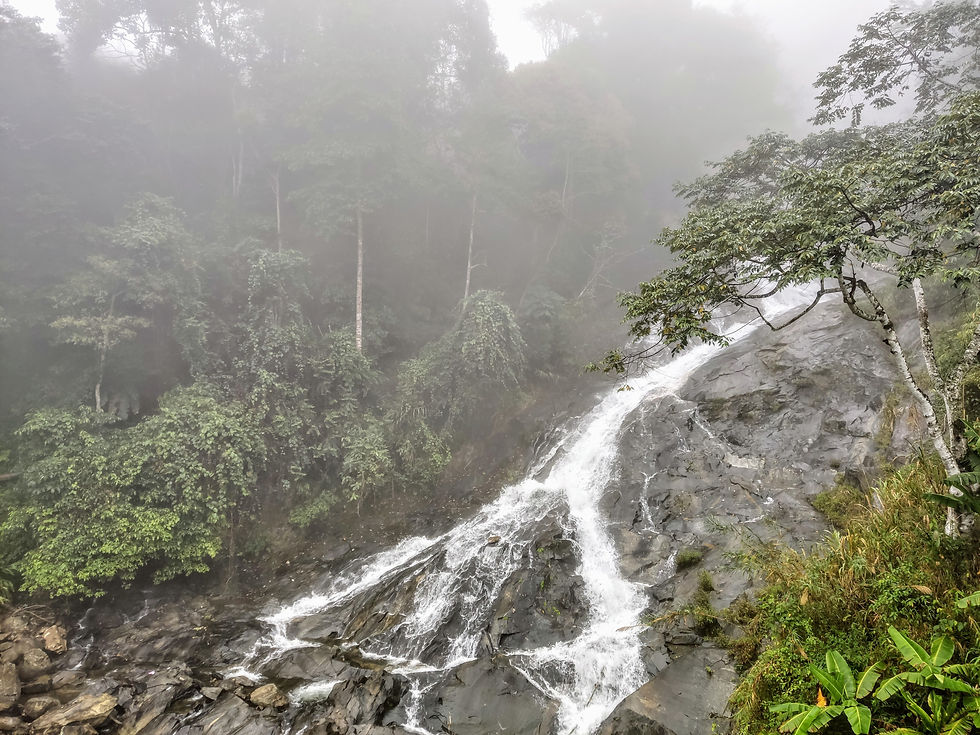
I rode through Kham Duc, site of yet another famous battle with nothing obvious to see and turned east on a road called QL14E. It was mostly empty, connecting some really small villages through the lush mountains. I stopped to take pictures at a beautiful dam and was swarmed by about a dozen teenagers who all wanted selfies with me.
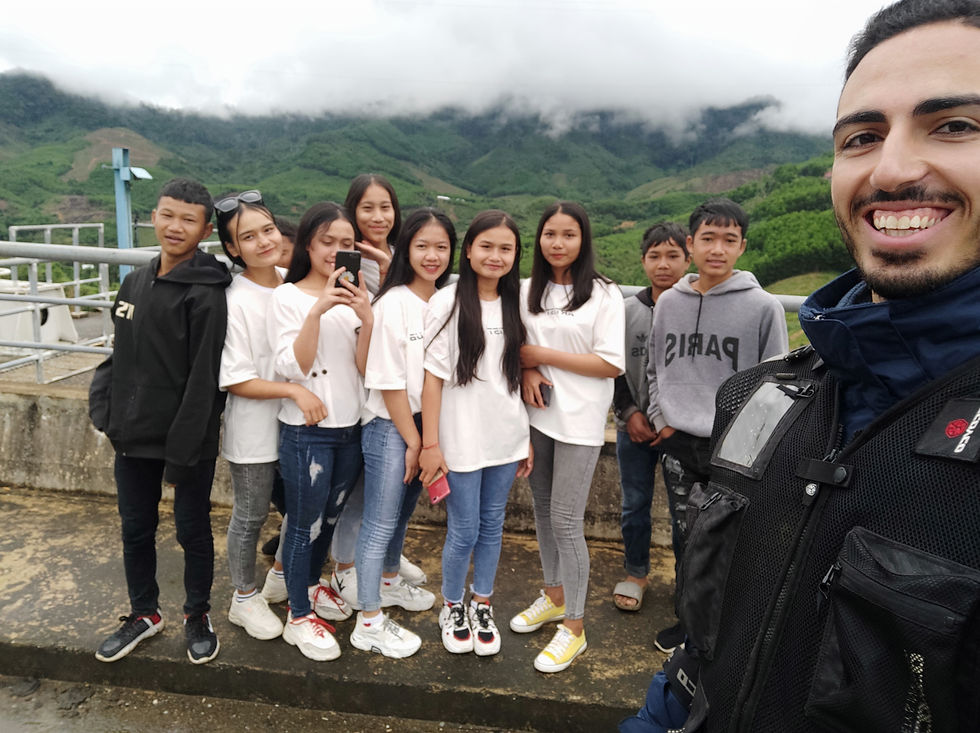
The road down to the coast was pretty and uneventful, apart from a motorbike very suddenly stopping short in front of me and causing a very minor fender bender, gradually losing elevation until I found myself on the main coastal highway which took me to Hoi An.
Laughing Gas Casualties and Bombed Temples
I was meeting Peleg and Roy, two of my closest friends from the military, who were traveling Vietnam north to south, so Hoi An was a natural halfway point for both of us. Unbeknownst to me until the day prior to my arrival, they were also traveling with three Israeli girls - Talia, Ella, and Einav - they had met in the Philippines and we were all staying in the same room. They were very typical Israeli tourists, sleeping in until noon, eating overpriced Western food and spending most of their time relaxing, so I had a hard time clicking with them but we had some good times.
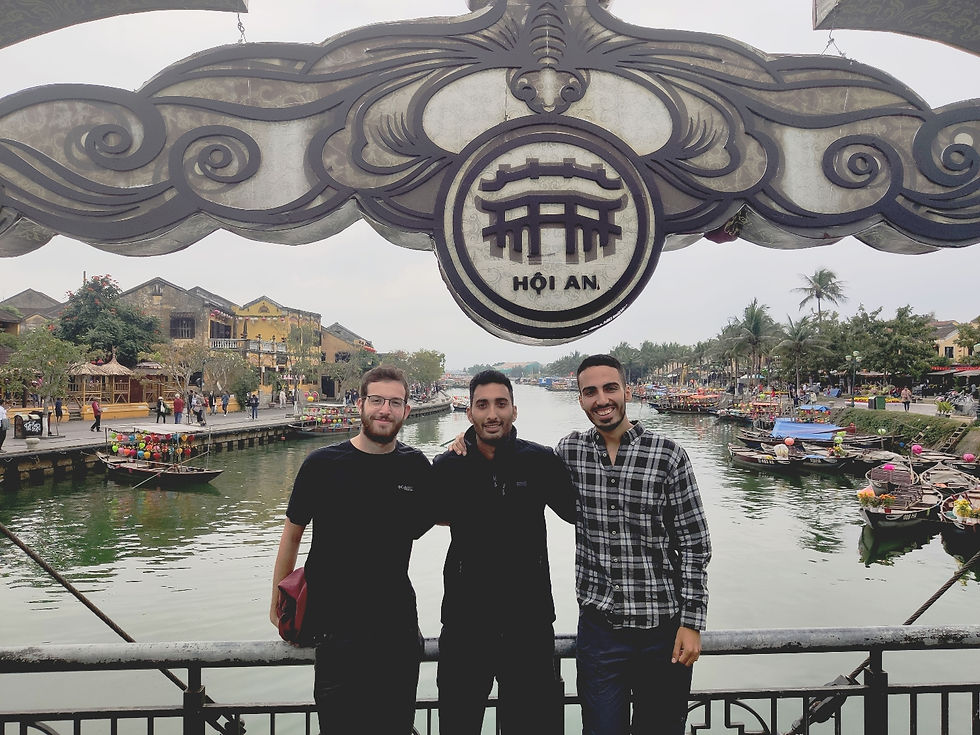
We went out to the Old Town in the evening, getting a boat ride on the canals and placing paper lanterns in the water. The whole thing was super kitschy, but it really was beautiful, the canals lit up with hundreds of lanterns and buzzing with people.
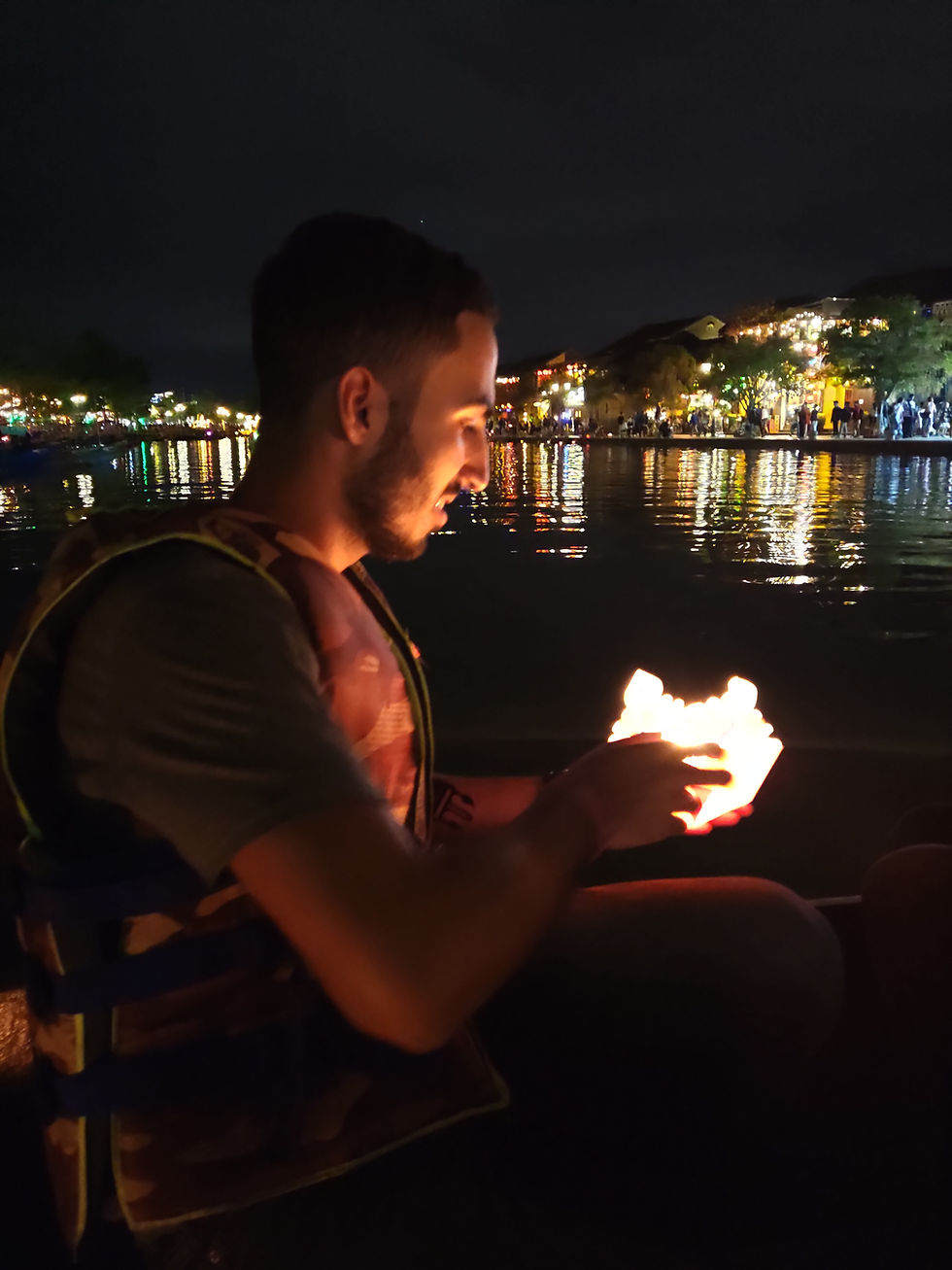
We were sipping cocktails in a bar that had seats made of oil drums when suddenly a girl sitting at the table next to ours collapsed. I rushed over and slowly helped her to her feet, trying to figure out if she was ok. As it turned out, she had inhaled an entire balloon of laughing gas (every bar and hostel in the country seems to sell them) and fainted. I thought she had a concussion, strengthened by the fact that she didn't remember the whole thing a few minutes later, but she wouldn't have any of it. After a few days in the isolated highlands, it was quite the reminder that I was back on the mainstream tourist track.
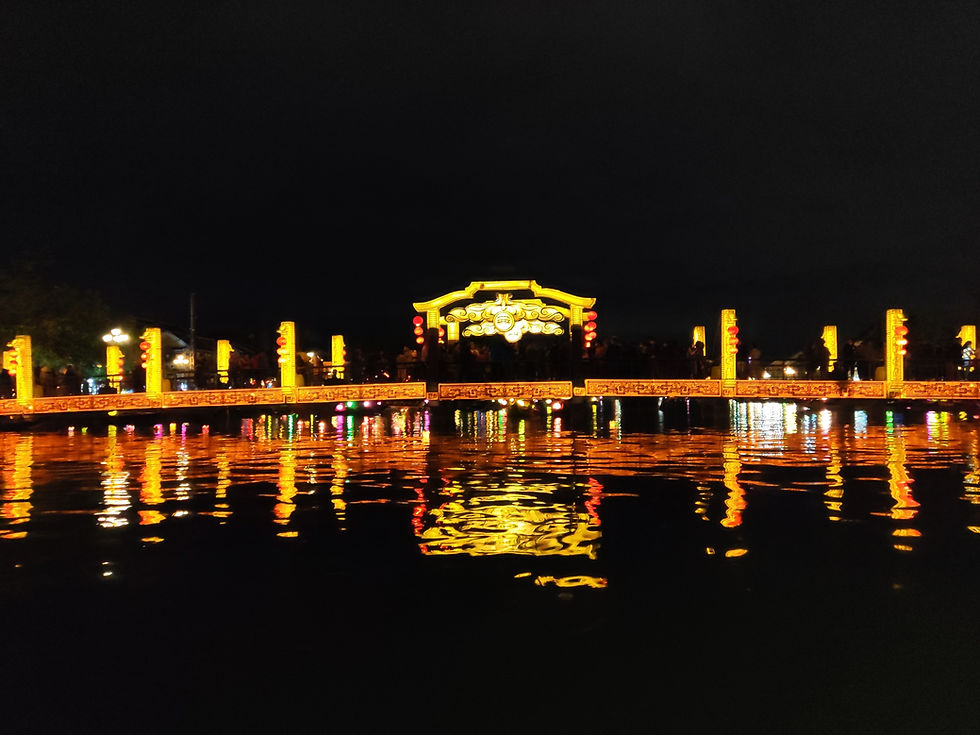
Thanks to the girls, we had a very late start in the morning. The plan was to visit ancient temples at Mỹ Sơn, but Ella and Einav said they weren't up for it, so we left them behind. I took Peleg on my bike and Roy took Talia on a scooter he rented, and off we set towards the hills.
Mỹ Sơn is an incredibly impressive site, with dozens of beautifully-designed Hindu temples in various states of repair, some as old as the 4th century CE. Sadly, it was also used as a hideout by members of the Viet Cong during the war, causing the US to bomb and shell the site, resulting in extensive damage to many of the structures.
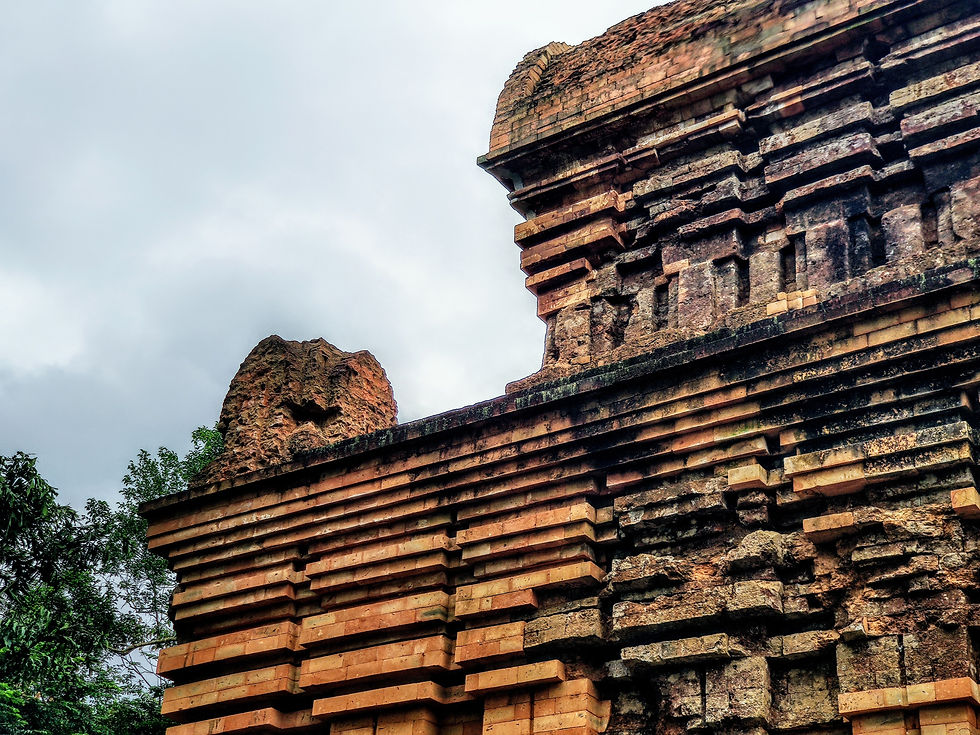
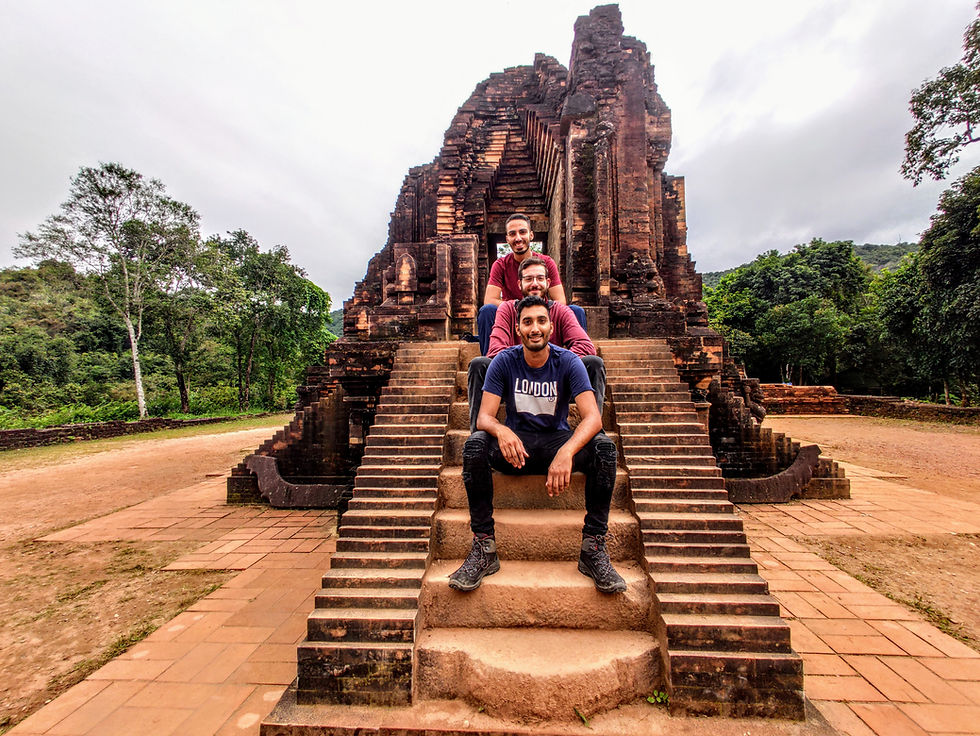
The way back was wild, Google Maps taking us on what was essentially a bike path with masses of motorbikes zipping in both directions for miles. I was worried the traffic would be too much for Roy, who had had no experience on a motorcycle before the Philippines, but we all made it back in one piece in time for happy hour at the main backpacker bar in town, the Tiger Tiger. We left at around 1, but the girls stayed later and said it closed at 2 and anyone who was still there was taken to the Tiger² bar, which was nearly 100% Israeli by that point. Did anyone say purgatory?
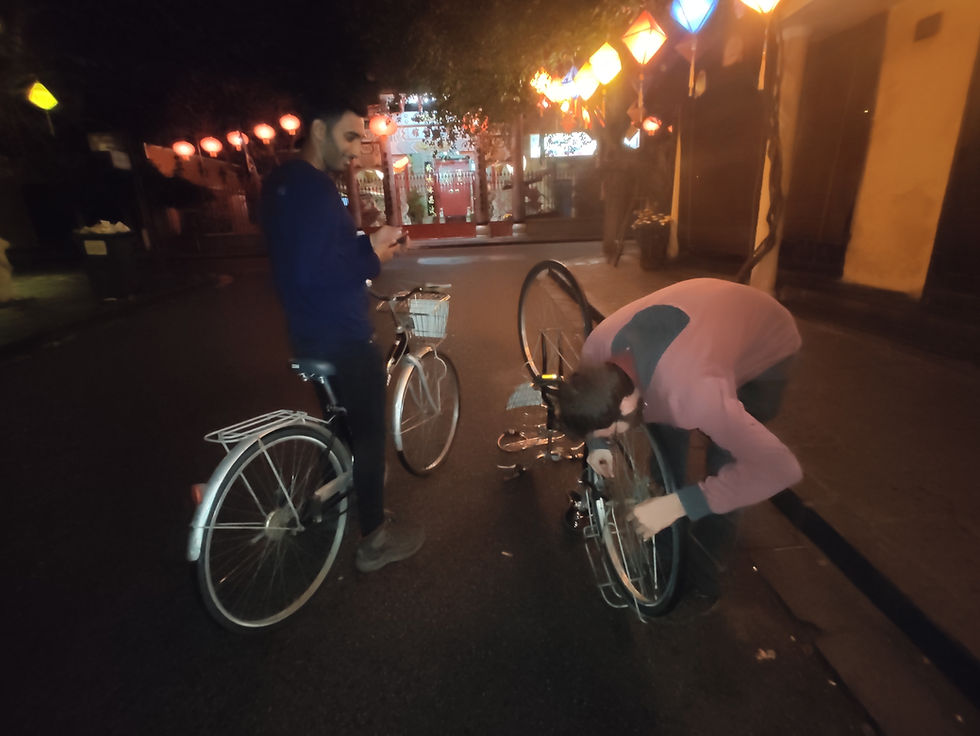
Hopefully-Tailored Suits
Finding decent breakfast options in Vietnam is no trivial issue if you aren't staying at a place that serves it. It seems the Vietnamese either have coffee or beef noodles for breakfast, neither of which work for me, and finding anything else can be a challenge. Even Hoi An, with its masses of Western tourists, was no exception, and it took us the better part of an hour to find a café that had croissants for lack of anything better.
Hoi An is famous for its quality inexpensive tailoring, and after being disappointed with some of the prices at the more upscale tailor shops, we headed to the cloth market to see if we could get a good deal. We were led into a shop, where after examining the fabrics we drove a hard bargain until finally settling on $180 to make Roy and me each a suit and a shirt to match. We got measured and were told to return two days later; I left the city the next day and let them pick it up for me, so I'll likely only see the finished products sometime in the summer and I hope they fit.
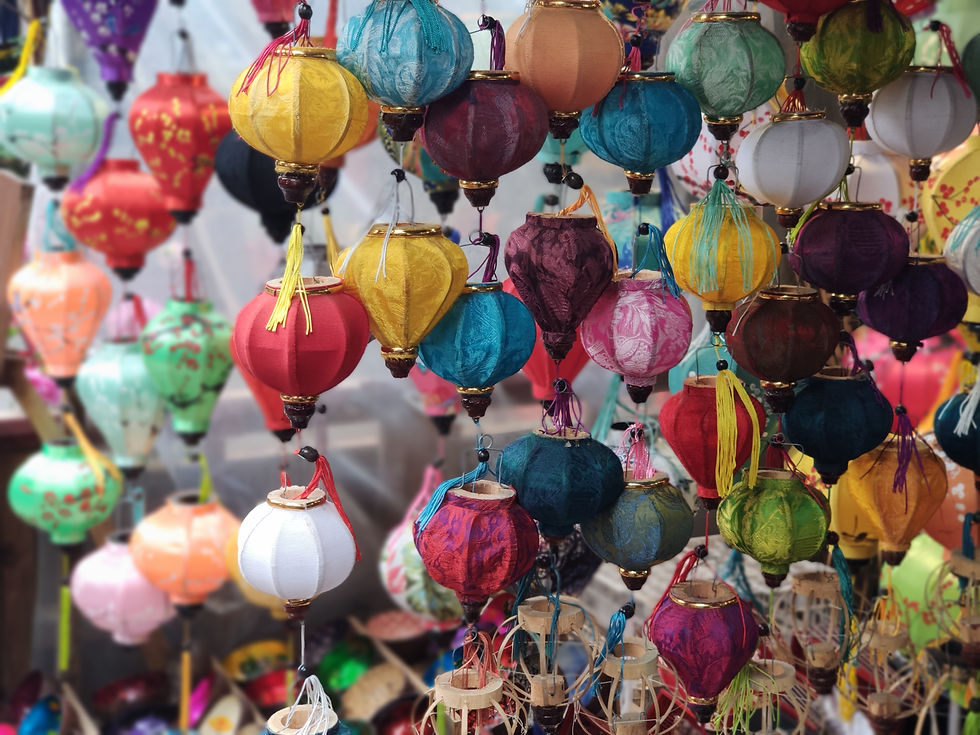
Spinning in the Thu Bồn River
We had booked a Vietnamese cooking class in the afternoon and were driven out to a family home in the village of Cẩm Thanh just outside the city. Over the course of roughly two hours, we made some really great dishes - papaya salad with spring rolls, grilled tofu with peanuts and chili, and beef noodles - all made from ingredients bought in the local market.
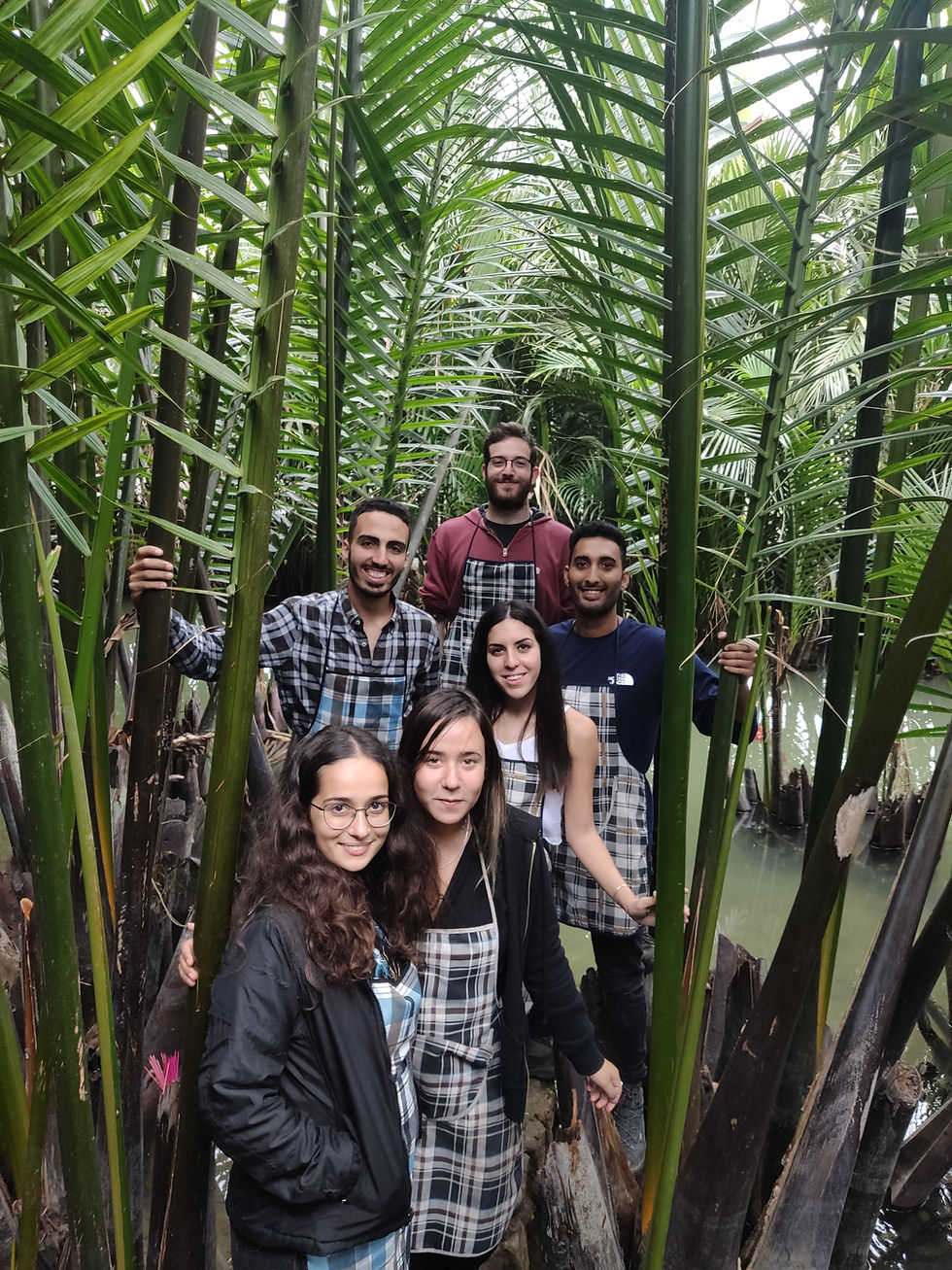
Cẩm Thanh is in the Perfume River Delta, with lots of canals and wetland, and locals use little boats that look like bowls to get around and fish. We split up into pairs, got onto boats, and tried out luck at crab fishing in the reeds. Our driver-captain was more successful than us, catching a crab and two babies, and proved his skills even further by spinning us around at breakneck speed, the water reaching within an inch of the lip of the boat. He then proceeded to sing and dance "Gangnam Style" while laughing hysterically, as the other boats watched on and cheered.
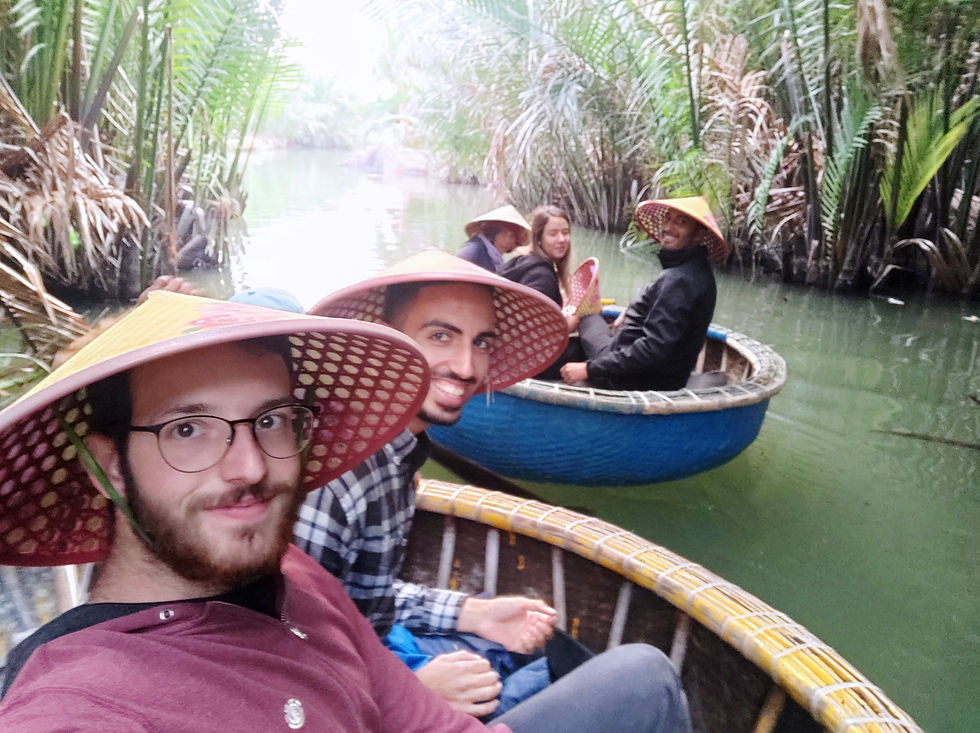
Happy hour at the hostel meant lots of rum and cokes, a dip in an unfortunately unheated swimming pool, and a bizzare conversation about love and depression with Talia, after which I headed out to the town with Peleg and Roy. It was only midnight, but everything seemed to be winding down.
We were making our way back when we were approached by three young Vietnamese men playing checkers by the road. They offered us a free ride, which seemed kind of sketchy, but the alarm bells weren't ringing yet. After failing to explain themselves in very limited English, one of them whipped out Google Translate and tried speaking to it. Most of what came out was unintelligible, but I did make out "100 dollars" and "young girls" (cue lightbulb sound effect). We politely declined and walked the rest of the way back.
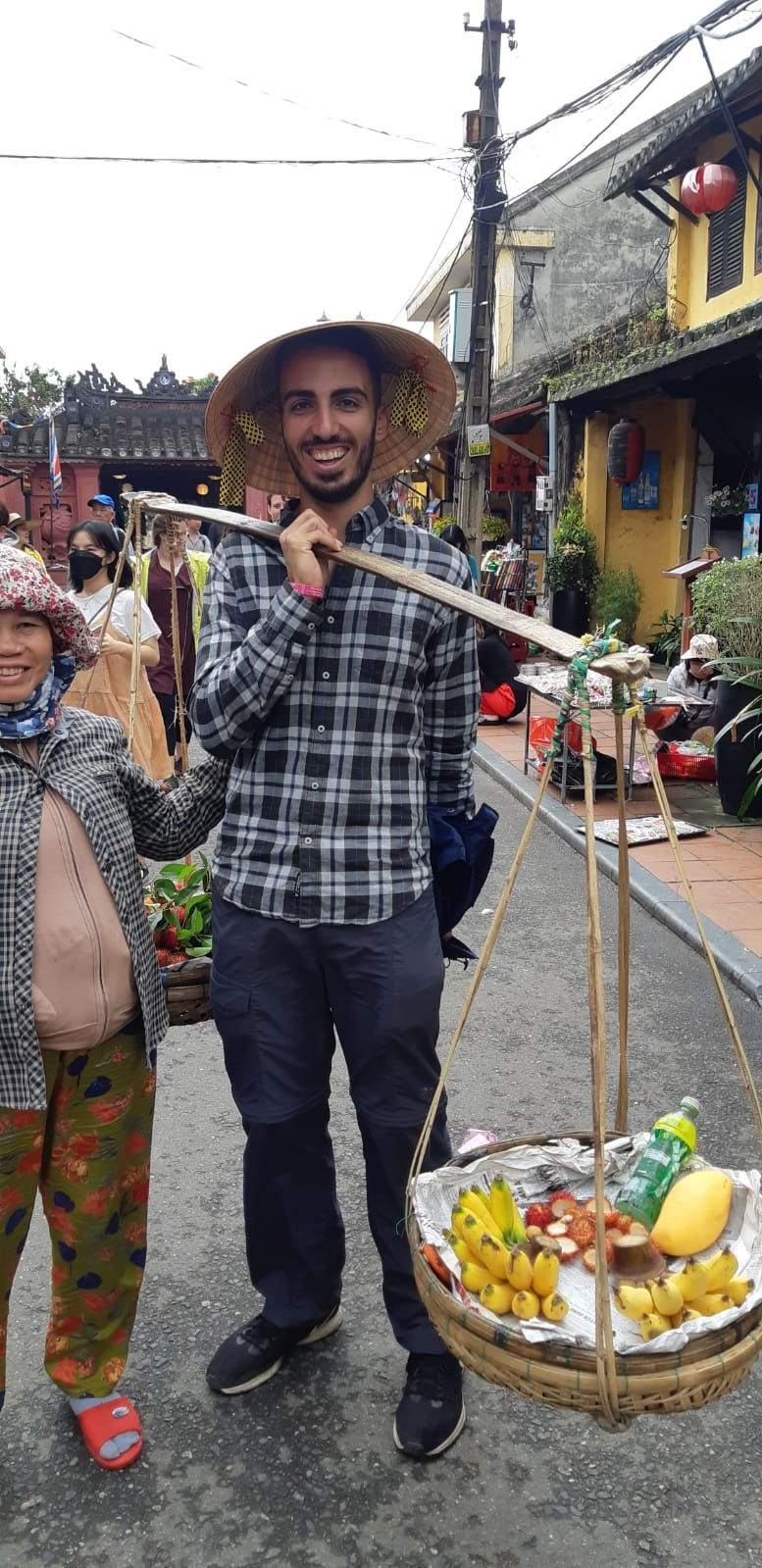
The Most Overrated Road in Vietnam
Back on the bike in riding configuration for the first time in 3 days, I rode north out of Hoi An until it merged with the city of Da Nang. It was very different riding from what I had been doing until now, miles never-ending wide boulevards lined with enormous resort hotels. Da Nang itself has a really modern-looking down town, with over-the-top enormous bridges crossing the Hàn River which flows through the city, including the Cầu Rồng which I rode across and is designed to look like a dragon. The only nice thing I could spot about Da Nang was the first proper bus system I had seen since leaving Ho Chi Minh City.
Da Nang has a natural border to the north where the mountains of the Annamite Range meet the sea. The coastal highway crosses the range at the famous Hai Van Pass, 21 kilometers of twisting tarmac relatively free of traffic since the Vietnamese government dug a tunnel beneath them. The pass is marketed as a "must-do" activity in Vietnam, causing the road to be full of tourists on rented motorbikes and more intense local riders on the first big bikes I've seen in the country.
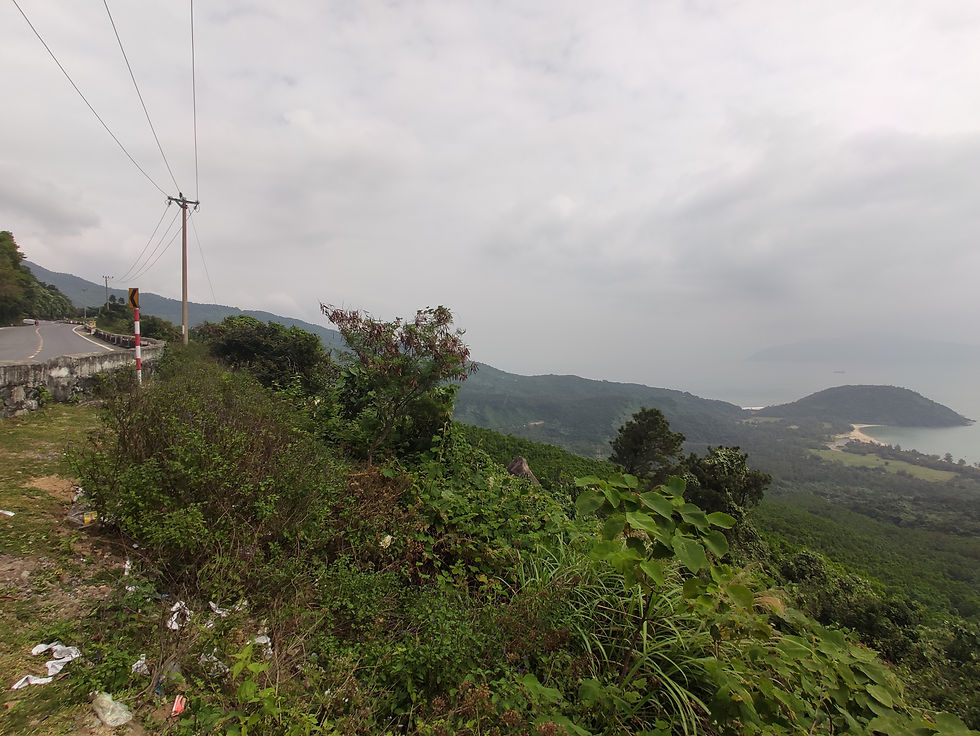
I honestly thought it was really overrated; there are much more beautiful (and empty) mountain passes in Vietnam, but the combination of sea and mountains at the same time was nice and there were some cool American bunkers and gun emplacements at the top.
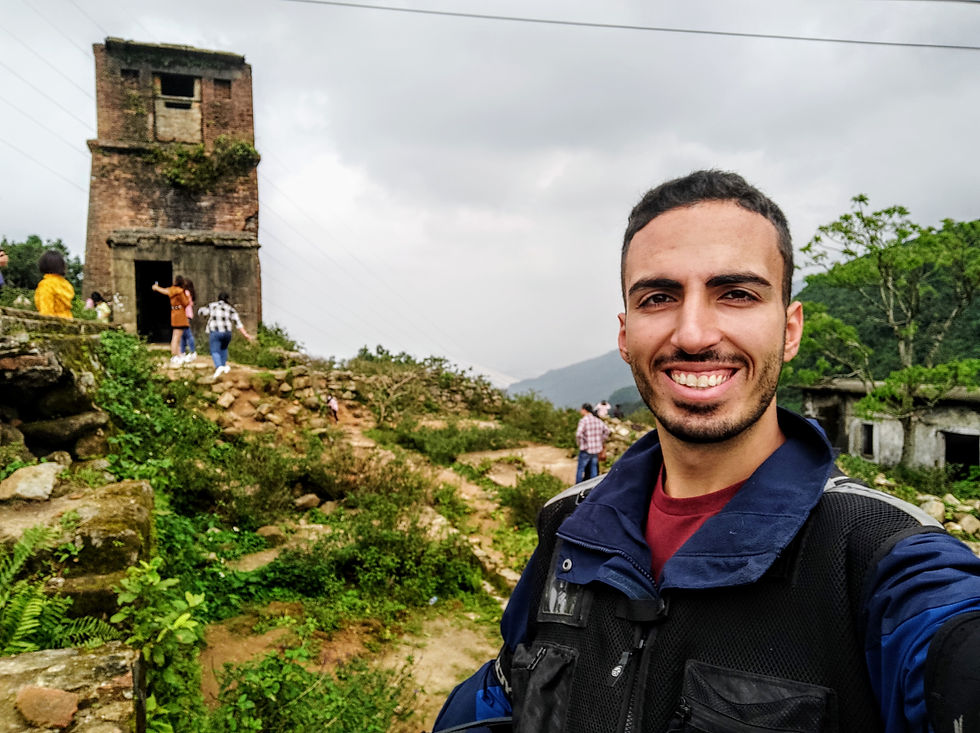
At the northern end of the pass, the road was blocked for a good 5 minutes to let the train cross it. This was the Reunification Express, the train route winding its way along the length of the country, connecting Hanoi with Saigon in a 34-hour long journey.
Realpolitik in the Rubble
The rest of the ride was on the QL49B road, taking me along a narrow peninsula very close to the coast. The road was equally narrow and quite rough, without any beach views to make up for it.
I arrived in the city of Huế in the early afternoon, happy I still had enough daylight to visit the only real attraction it has to offer. Huế is the former seat of the Vietnamese imperial capital, and the center of town is dominated by a massive citadel four kilometers square full of palaces and gardens, with one of the largest flags I've ever seen at the entrance overlooking the Perfume River.
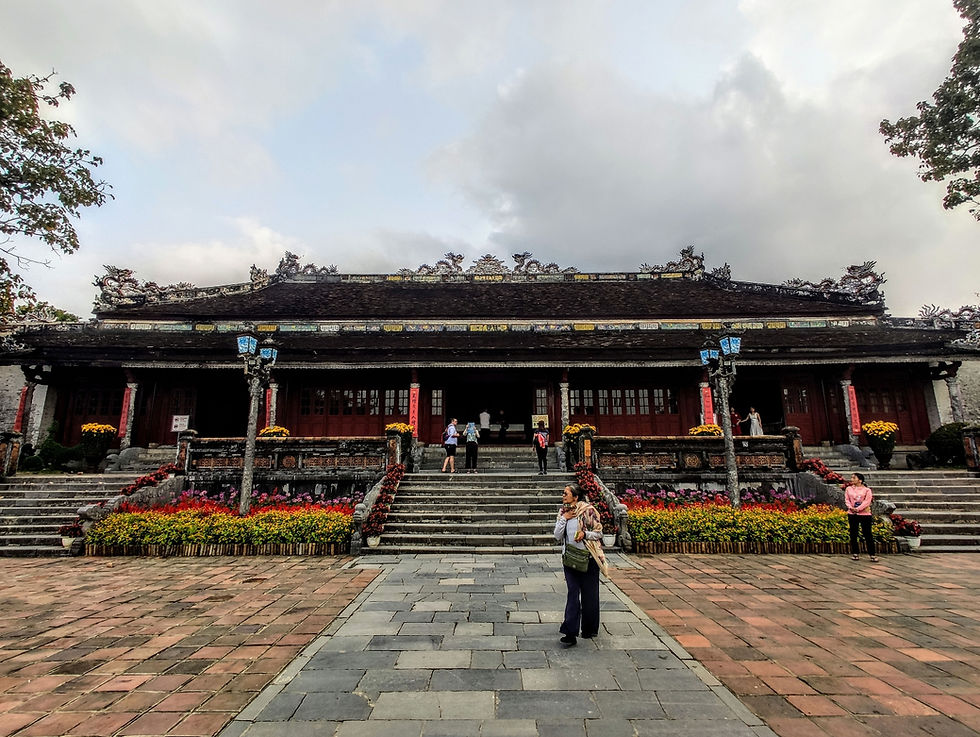
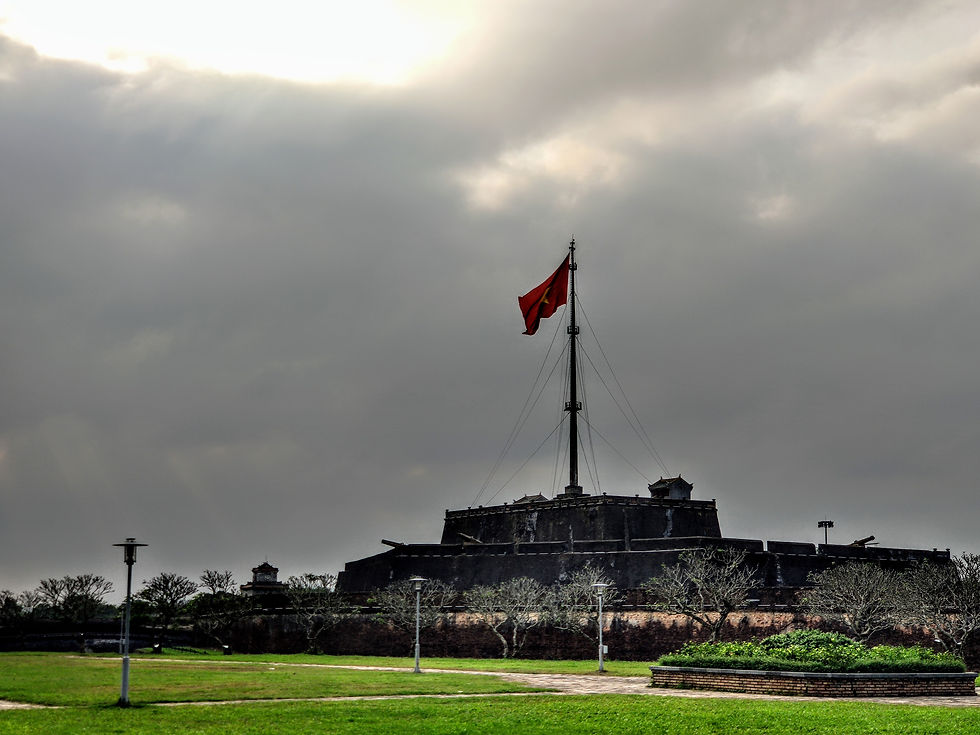
Unfortunately, the same citadel was also the epicenter of one of the bloodiest battles of the Vietnam War. North Vietnamese and Viet Cong troops overran the city during the Tet Offensive of early 1968 and turned the citadel into a modern fortress, lining the walls with anti-aircraft guns and successfully repelling massive efforts to retake it. US and Southern forces were initially under orders not to use artillery or air strikes to prevent damage to the ancient city, but as casualties mounted the restrictions were gradually lifted. The battle lasted over a month and resulted in the near-flattening of the city, with thousands of civilians killed indiscriminately, principally by Communist forces.
Today, part of the citadel has been restored to its former glory, beautiful Chinese architecture and peaceful gardens hemmed in by canals fed by the Perfume River. Placards on the wall explain the history of the place and proudly exhibit historical documents providing evidence for Vietnamese sovereignty over the Paracel and Spratly Islands of the South China Sea, currently occupied by the Chinese who claim all the waters starting 12 miles off the Vietnamese coast and have been hard at work turning the islands into military bases.
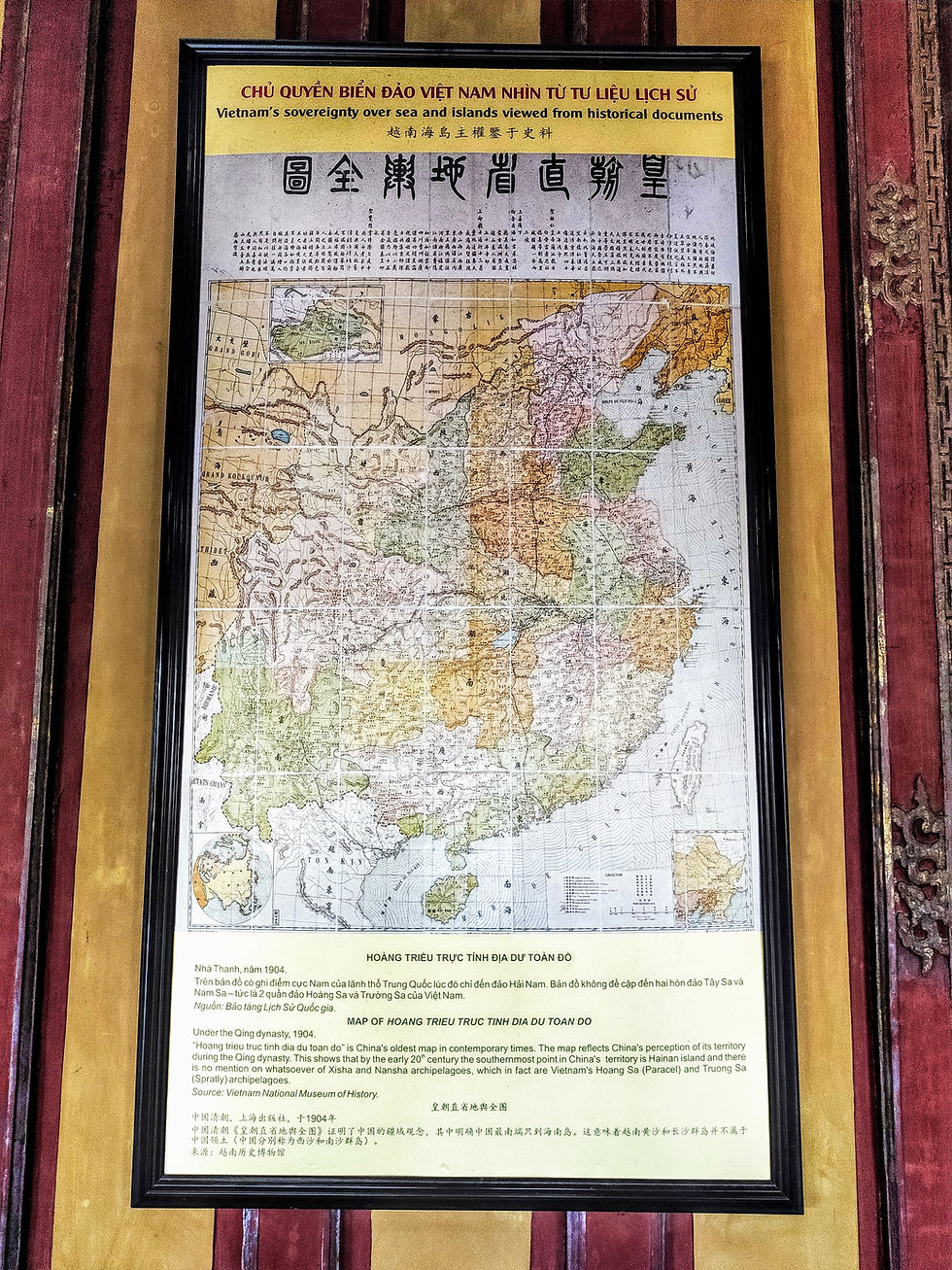
This occupation is a major source of concern for Southeastern Asian governments, principally Vietnam and the Philippines, which in a fantastic twist of realpolitik has pushed them closer to the US in recent years. 50 years ago, the Chinese were arming Vietnam to resist American aggression; today the Communist Party of Vietnam, the same people who put up fierce resistance on the ground I'm standing on as the US military pulverized one of Vietnam's most important cultural sites, is rapidly cozying up to the same military in an effort to resist Chinese expansionism.
Passing the propaganda and history posters, none of which mention any of the war crimes of 1968, much of the citadel is still in ruins, a vivid reminder of the destruction wrought by the war over half a century ago. The scars are visible in other parts of the city as well, where the construction of wide and straight boulevards was facilitated by the city being reduced to rubble.
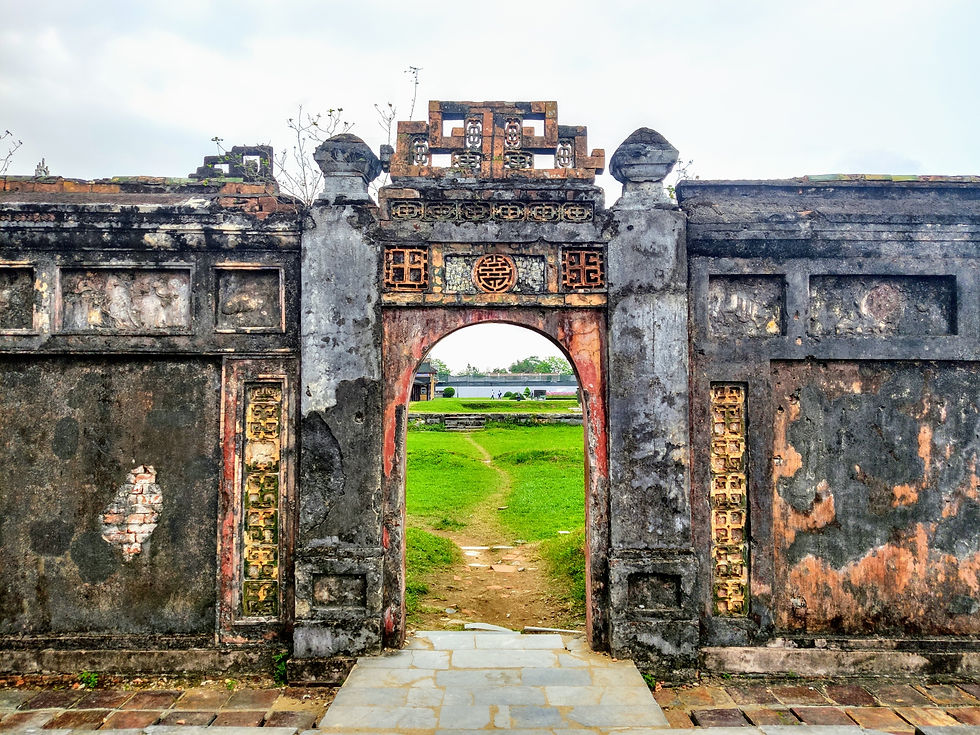
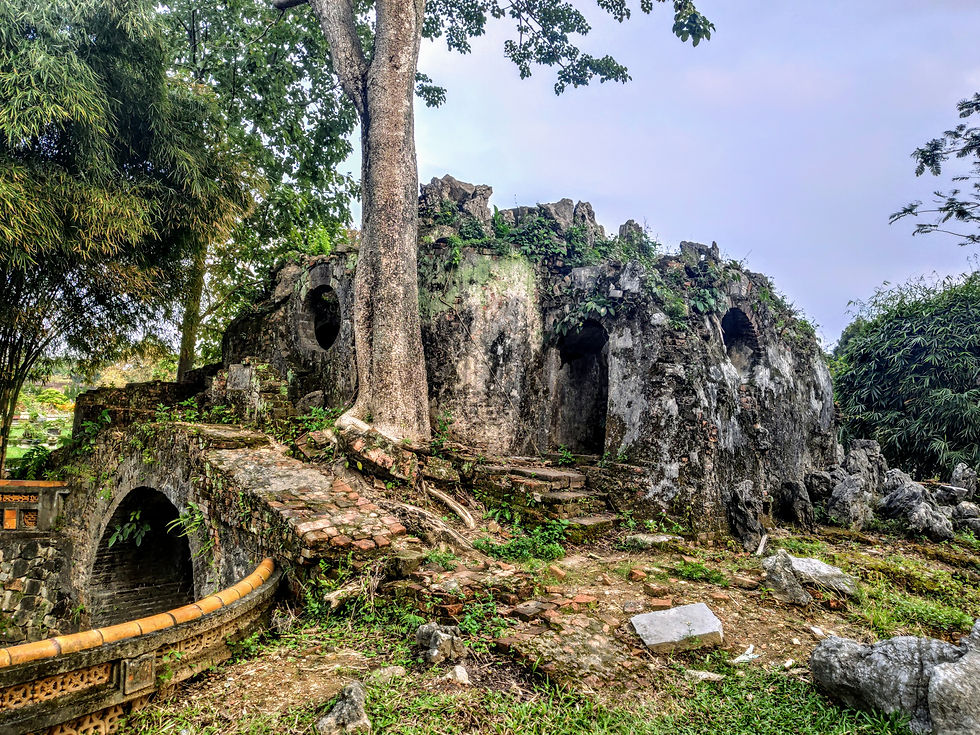
I was staying at a lovely homestay in the main tourist area of Huế and had dinner at a local restaurant with just about everyone else who was staying there. I met Noa and Dana, twin sisters from Tel Aviv, and we hit the town with some of the other guests in search of ice cream and karaoke. As if to demonstrate Vietnam's shifting alliances I had been pondering only a few hours earlier, Huế has a Baskin-Robbins, in which two small scoops of mediocre ice cream costed more than the noodles and beer I had had for dinner, but I was doing it as a practical student of geopolitics.
More Official Bribes
Several kilometers south of Huế is Thuỷ Tiên Lake, one of Vietnam's stranger tourist attractions. It's not the scenery that brings people here, but a glitzy water park built in 2003 and abandoned a few years later. The site is officially unaccessible and the access road is blocked with a gate, but I parked my bike just before it and headed down a forest path I was told led to the park. I had barely walked 200 meters when a guy pulled up on a scooter and said the park wasn't safe to visit and that I couldn't climb on anything. He asked for a "tip", a request I would ordinarily decline, but I had read the "guards" would block your access if they weren't paid off and it was only 20,000 dong (<$1).
Continuing down the path, another guy showed up and pulled out a handwritten sign in English saying the park was off-limits for safety reasons. I tried telling him I only wanted some photos, but he was adamant and refused to let me pass. I was just going to tell him about the "tip" I had paid his friend and offer him one as well when he got a phone call. It lasted about 15 seconds and at the end he just rode off, all previous resistance forgotten, after I assume he had been informed directly.
I finally reached the park, taking in water slides, an amphitheatre, and a three-story dragon with a viewing platform in its mouth, all looking very sorry in their abandoned state.

It was eerie, almost unsettling, but I love exploring abandoned places and this was one of the better sites I've visited.
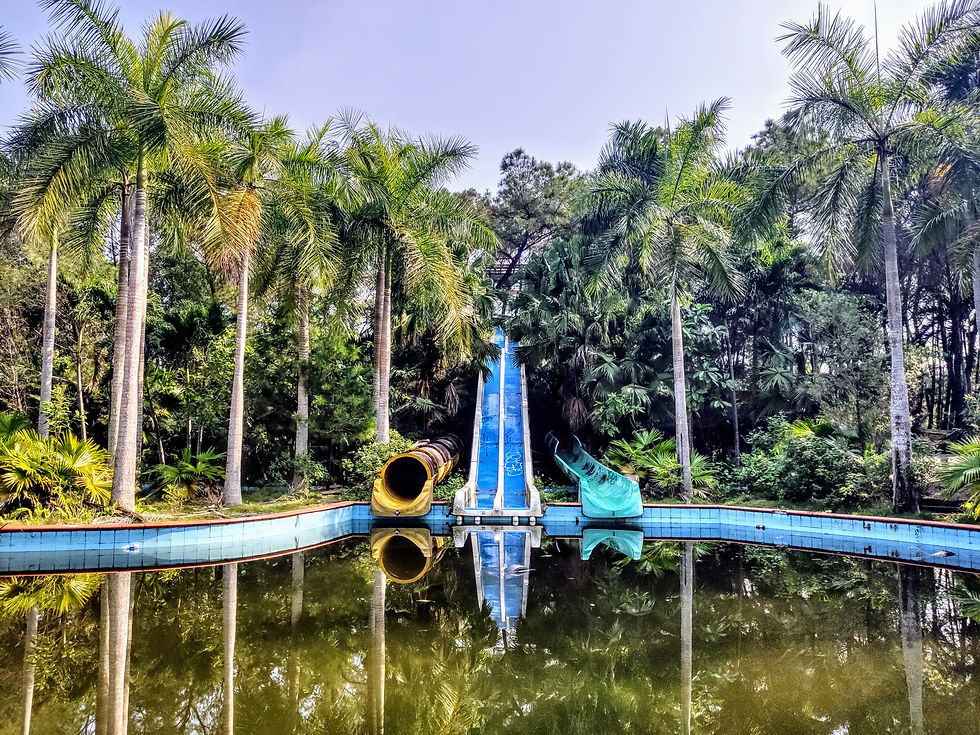
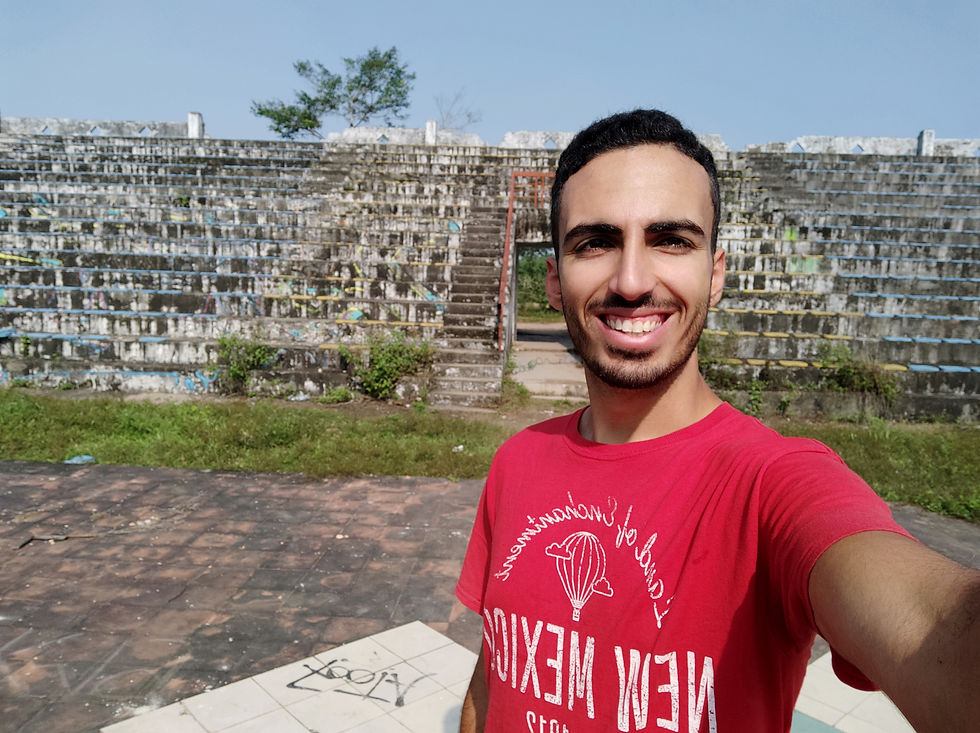
Demilitarized Tourism
After circling the lake to reach my bike, I set off north on the dreaded QL1A, the truck-filled coastal highway I try to avoid, on a self-guided tour of the former demilitarized zone between North and South Vietnam.
My first stop was the Church of Our Lady of La Vang in the town of the same name. The church is built on the site of an apparent sighting of the Virgin Mary in 1798 and has been destroyed twice since, first in the 19th century and again during the heavy fighting of 1972, leaving essentially a shell of the old brick building pockmarked with bullet holes. A third, massively grandiose church is under construction behind the destroyed one, a metaphor for the cycle of construction and destruction in this country.
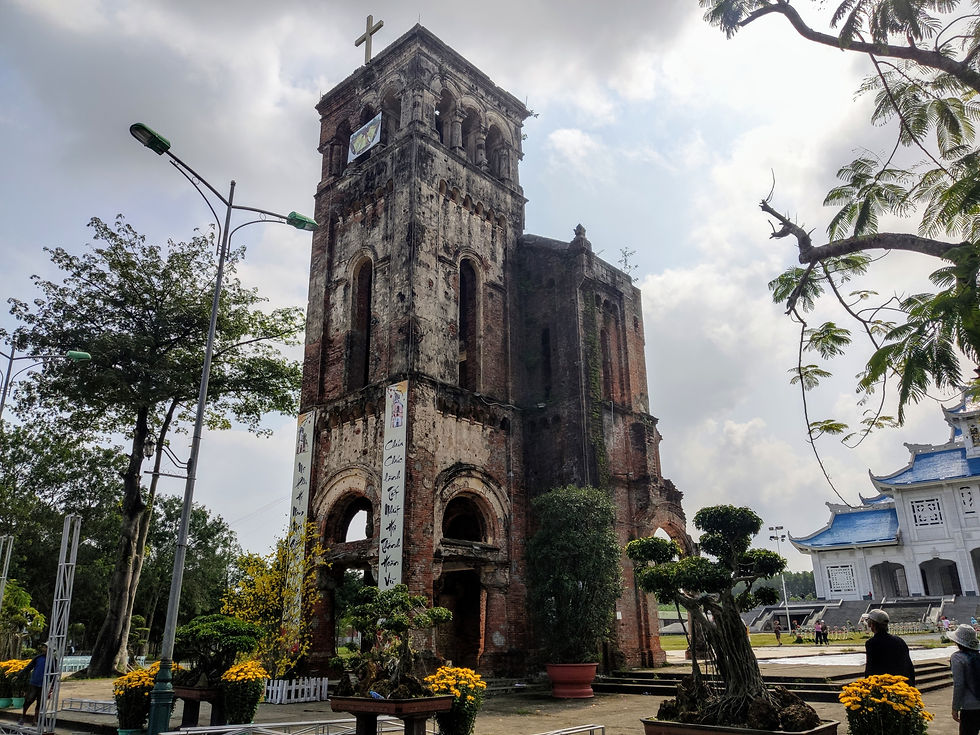

A few kilometers north is the small city of Quảng Trị, capital of the northernmost province in South Vietnam. As such, the city saw heavy fighting throughout the war, the climax of which was when Communist forces seized it during the Easter Offensive of 1972. In what was becoming a familiar pattern, Communist forces retreated to the antique citadel in the city, where they withstood 81 days of siege as US and Southern forces turned everything around them to rubble. Nothing from the citadel remains besides the moat and some wall fragments and the site is now a well-maintained memorial to the thousands of soldiers who lost their lives there.
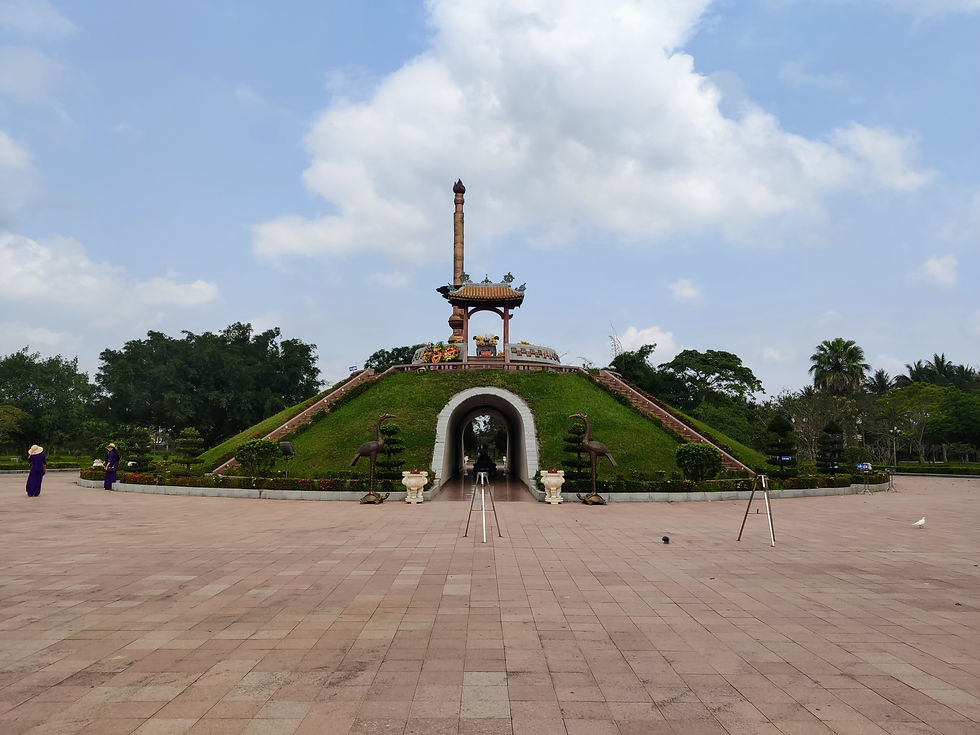
Next stop was the Hiền Lương Bridge, the actual former border between North and South Vietnam which ran through the Bến Hải River. The northern side has a massive Vietnamese flag, loudly flapping in the wind above a map proudly displaying the provinces of united Vietnam; the southern has an empty base of the flagpole on which the flag of South Vietnam once flew and a long-empty watchtower overlooking the river.
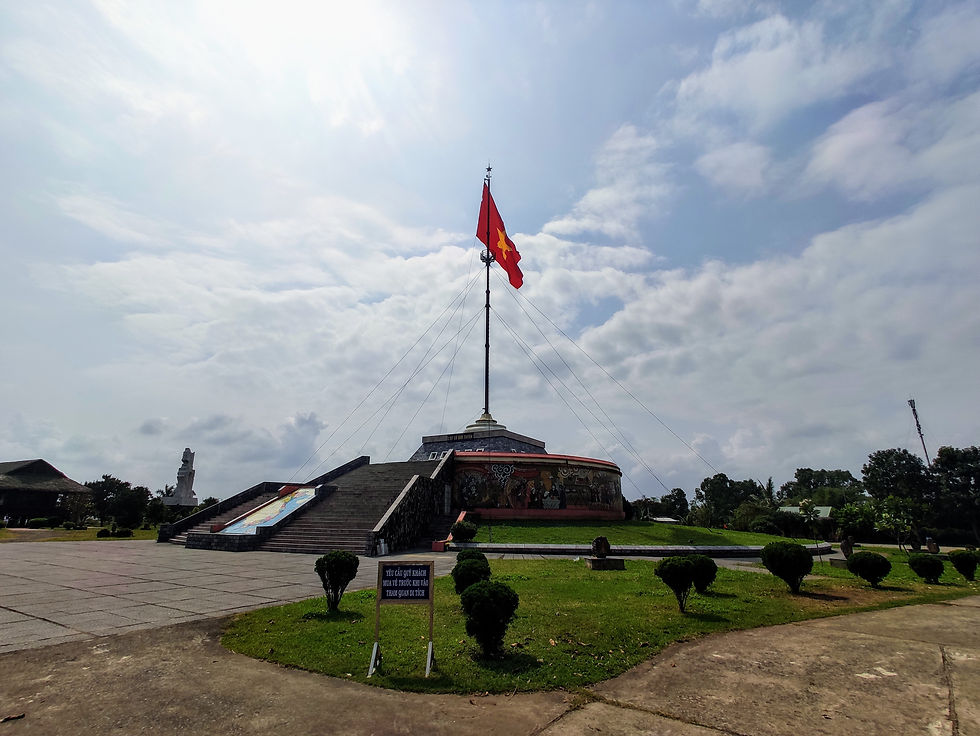
The hut on the southern bank which once held UN inspectors monitoring the border has been restored, complete with creepy wax figures of said inspectors and a Vietnamese woman serving them tea. I rode across the old bridge which has since been replaced by a much wider one and crossed the former border.
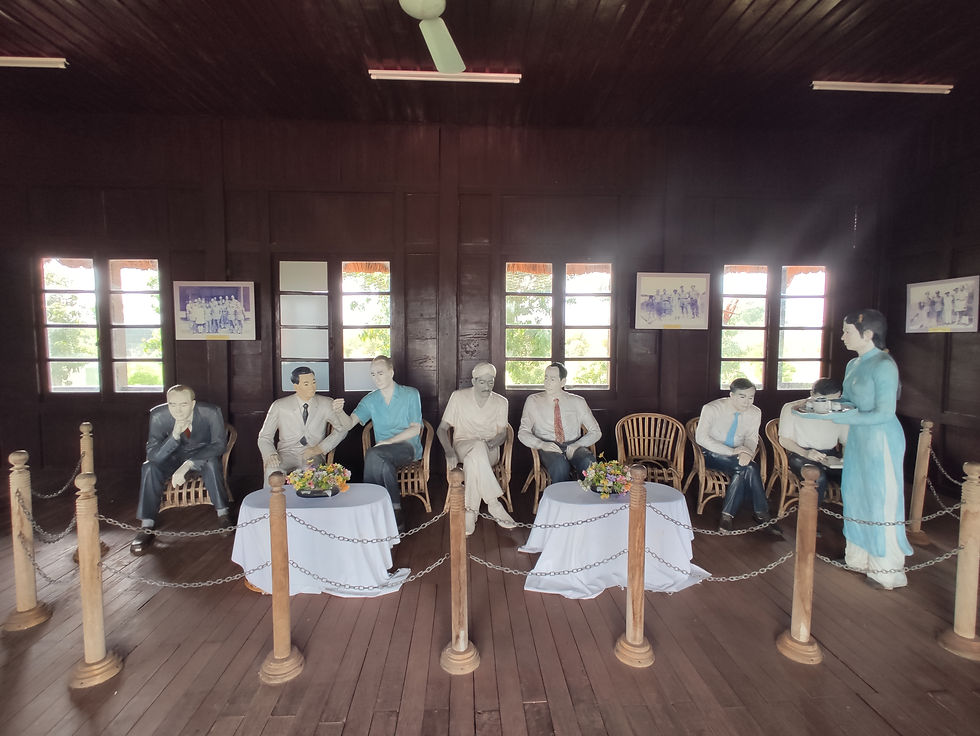
A short ride on what was essentially an empty bike path brought me to the coast at the village of Vinh Moc. Being the frontier region it once was, this district of Vinh Linh saw some of the heaviest bombing and shelling of the war, with 7 tons of bombs being dropped for every resident of the district. Unable to live amidst the bombing and unable to leave ("refusing to cede one inch of land to the imperialist enemy" in the words of the half-hour propaganda film I watched), the residents and soldiers in the area dug hundreds of tunnels and essentially moved their villages underground. The tunnel complex at Vinh Moc has been preserved nearly in its entirety, offering a glimpse at what this underground life must have been like.
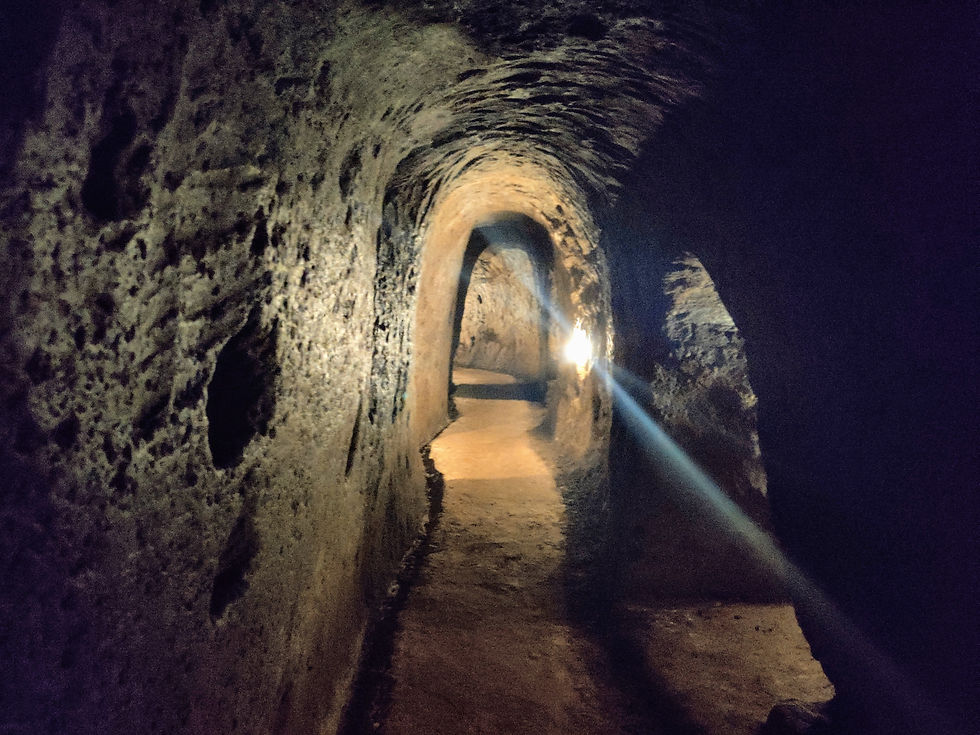
After recovering from walking bent over for the better part of an hour (the Vietnamese villagers and soldiers weren't digging for 6'1" tourists), I was amazed by both the feat of engineering that the tunnels were, over 40 kilometers of underground passages dug without heavy machinery, and by the perseverance of the villagers who stuck it out in the tunnels as their homes were destroyed.
The tunnels are open for exploration without set points for entry and exit, so I found myself on the beach nearly a kilometer south of where I started and too disoriented to try and make it back through the tunnels.
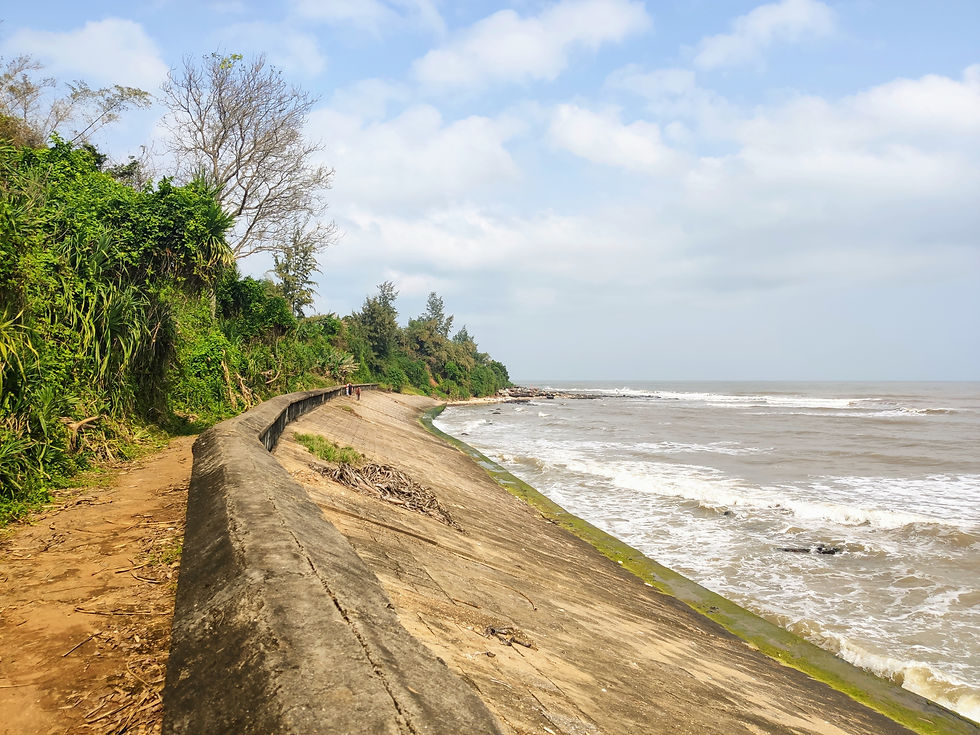
Some trapising through a forest later, I was back on the bike and headed to Trường Sơn Cemetery, the Vietnamese Arlington for victims of the war. The cemetery is immaculate and surprisingly Buddhist for a Communist military cemetery, with pagodas interspersed between the burial areas, which are sorted by geographical regions.
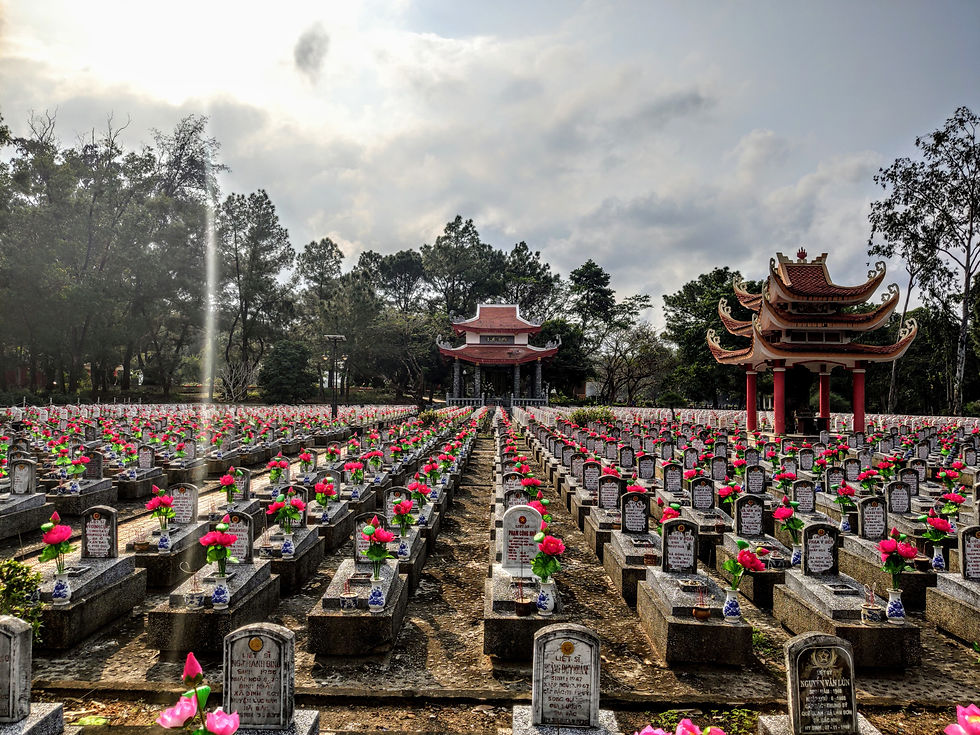
Riding around the road that surrounds it, I got a better sense of the scope of the war after seeing the hundreds and thousands of neat rows of graves covered with plastic flowers. Some naval officers were there as well, paying their respects to the victims of Hanoi and performing a short ceremony which was rather hard to follow.
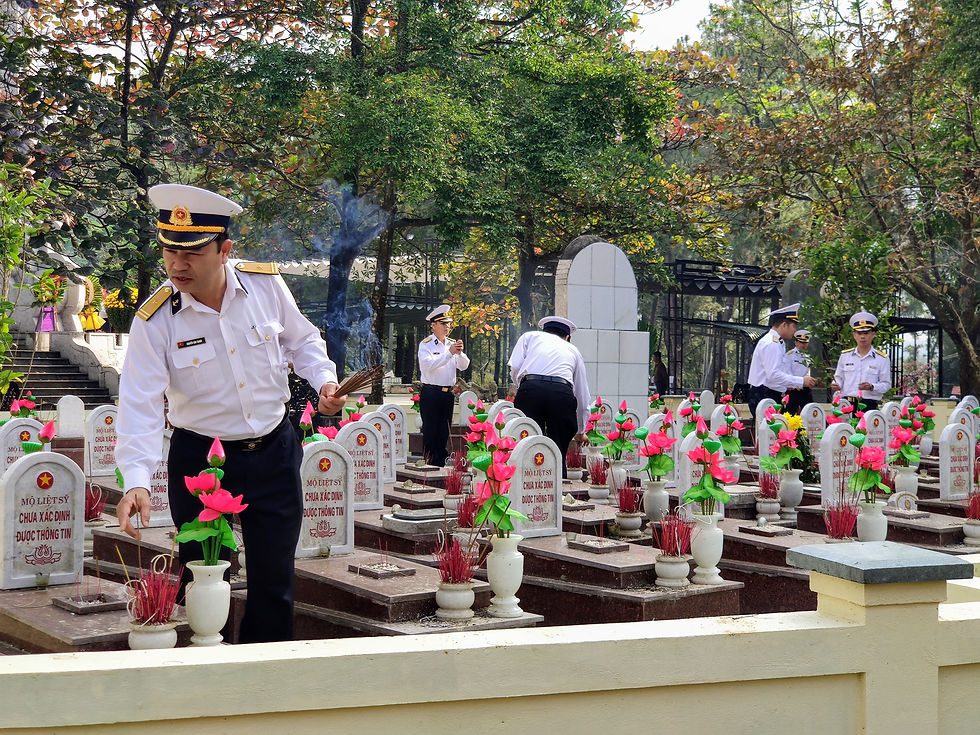
I briefly headed south on the Ho Chi Minh Road, headed for the AH16 road towards the Laotian border, and stopped for some delicious noodles and milk tea in a small village, where kids on their way back from school were eating all around me, pointing at my riding gear and giggling.
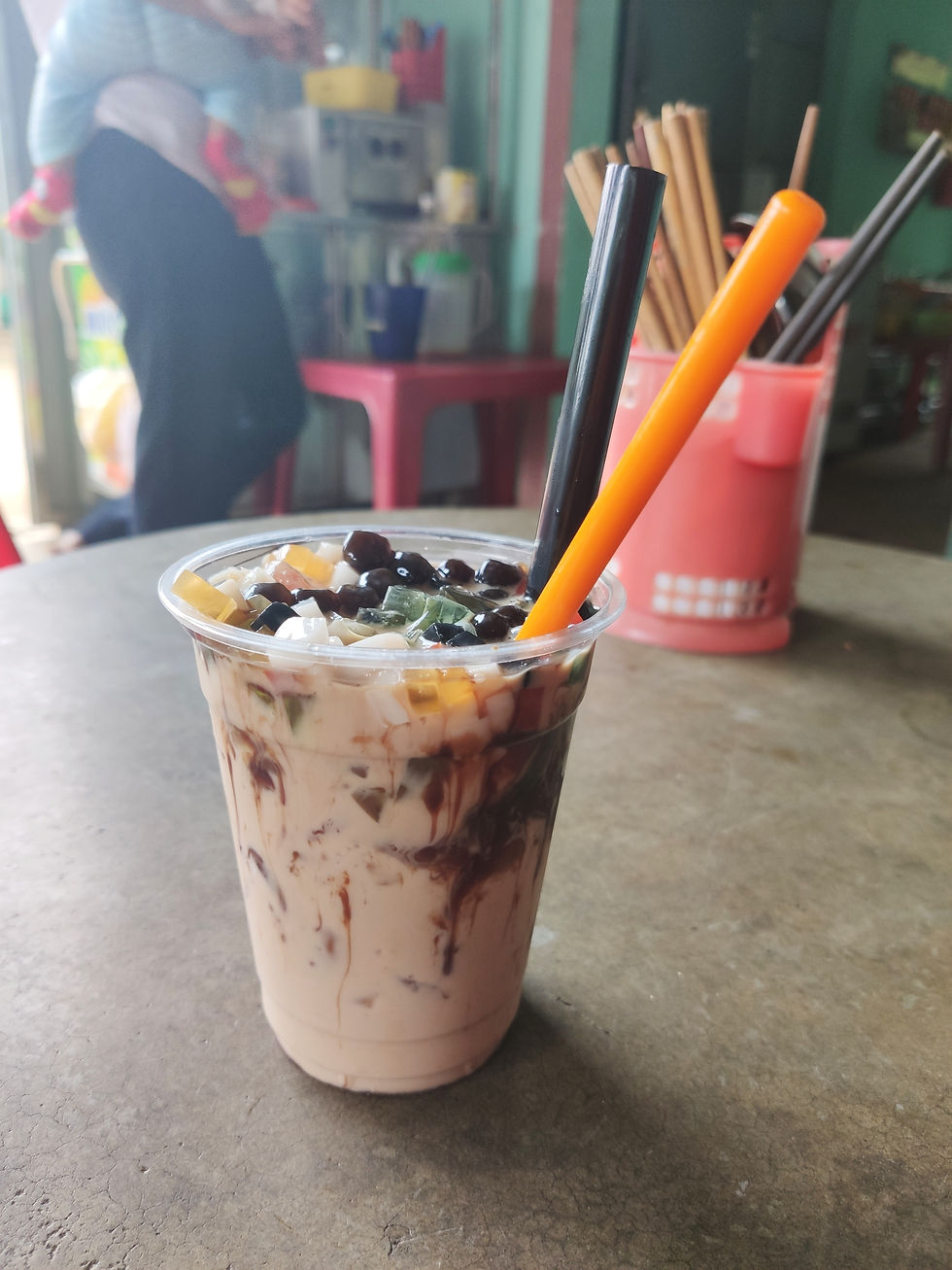
Leaving the coast behind, I started climbing back into the mountains, the scenery more dramatic than in the Central Highlands. The DMZ touring had taken longer than expected and I was running out of daylight, so I had to be content with taking a picture from afar of The Rockpile, a former Marine post nearly on the border and a brief visit to the site of Camp Carroll, now marked with a modest memorial. I reached the magnificent Dakrong Bridge, built in 1974 on the site where the former Ho Chi Minh Trail crosses the main highway, right after sunset and had to resist the urge to take photos of the bike one it.
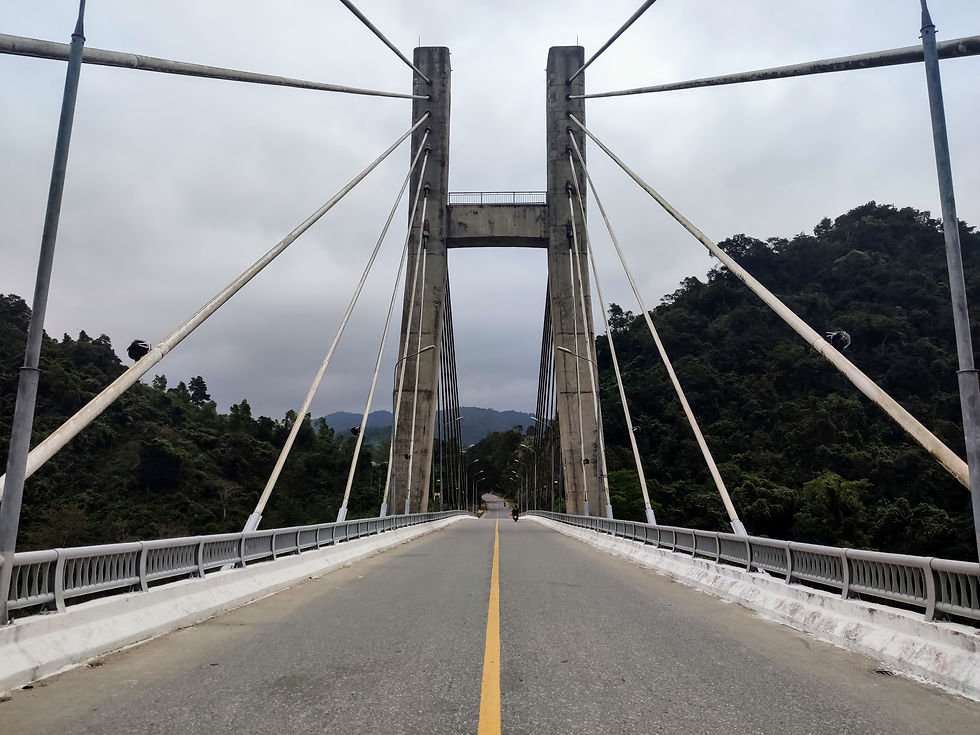
I pressed on to the town of Khe Sanh, site of a famous American base, on a road that would be fantastic if not for the masses of trucks heading to and from the border crossing at Lao Bảo. Khe Sanh was the smallest place I had stayed so far, a real highway town with rudimentary hotels catering to adventurous tourists and truck drivers and more mechanics than restaurants, but at least I had a place to get my oil changed and my chain tightened, if not to meet other travelers.
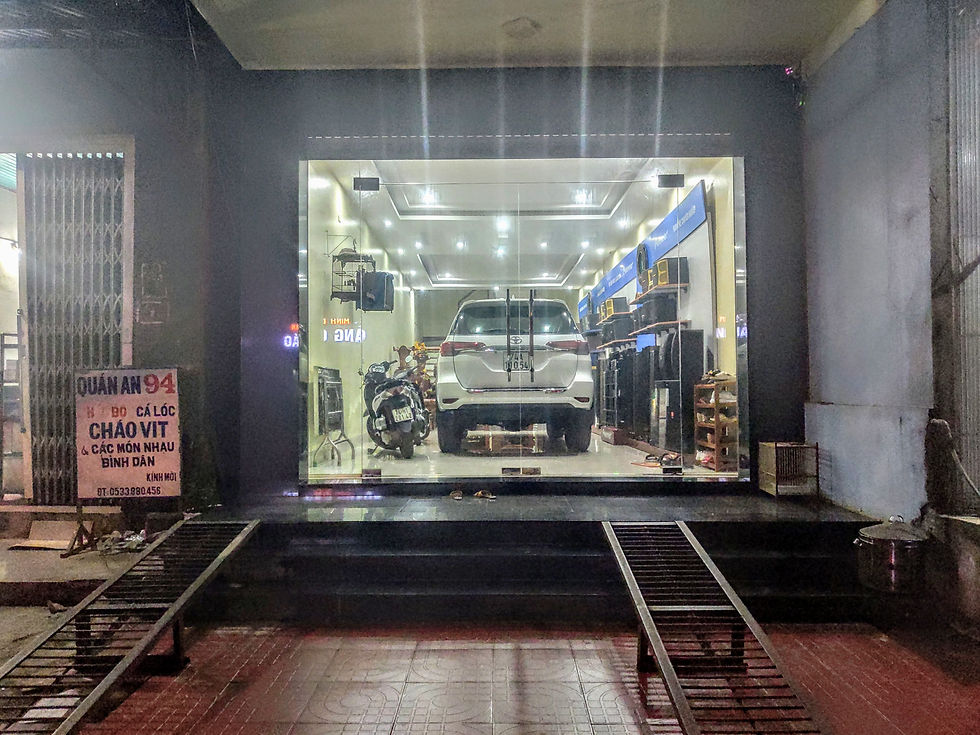





Comentarios